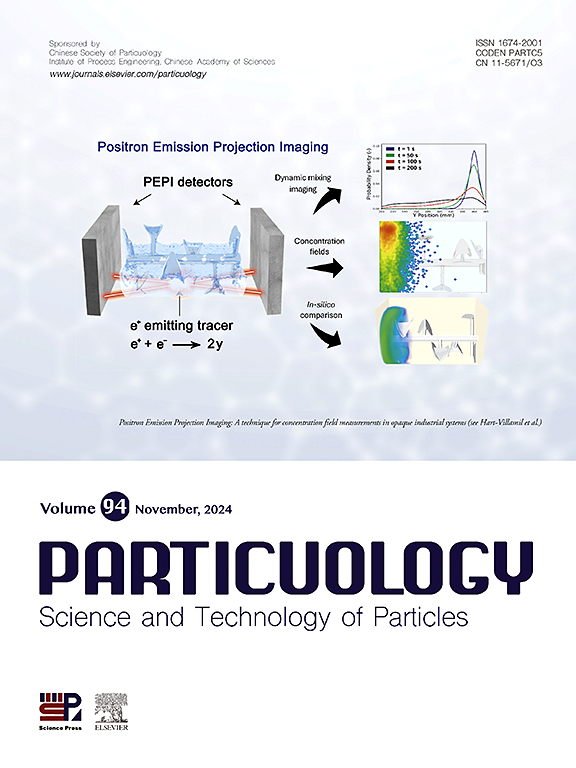通过建立基于形状的晶桥生长模型,快速评估非球形晶体的结块趋势
IF 4.1
2区 材料科学
Q2 ENGINEERING, CHEMICAL
引用次数: 0
摘要
晶体结块是影响高端精细化学品质量的决定性因素,而缺乏对结块形态的了解会造成大量的时间浪费,严重耽误高端精细化学品的开发。在此基础上,我们开发了一种基于形态的结块评估模型,与之前的建模实验和非建模实验相比,分别节省了 74% 和 96% 的时间,同时保证了卓越的准确性。晶体形态是长径比和粒度分布的函数。推导出了这些参数与结块倾向之间的定量关系,首先建立了形态抗结块标准。对于 D- 阿洛酮糖晶体,考虑到湿度和粒度,长径比低于 3 是防止结块的标准,这在以前还没有报道过。本文定量描述了晶体形态对结块行为的具体影响。所获得的知识可用于快速、定量地设计仓库中产品的防结块存储系统。本文章由计算机程序翻译,如有差异,请以英文原文为准。

Rapid evaluating caking tendency of nonspherical crystals by developing a shape-based crystal bridge growth model
Crystal caking is a decisive factor affecting the quality of high-end fine chemicals, whereas lack of shape-to-caking understanding results in considerable waste of time, severely delaying high-end fine chemical development. On this basis, a morphology-based caking evaluation model is developed with 74% and 96% time savings compared to previous modeling and non-modeling experiments, respectively, while guaranteeing superior accuracy. The crystal morphology is expressed as a function of the aspect ratio and the particle size distribution. The quantitative relationships between these parameters and the caking tendency are deduced, firstly achieving morphology anti-caking criterion establishment. For D-allulose crystals, considering humidity, and particle size, an aspect ratio is below 3 is the standard for combating caking, which has not been reported previously. Herein, the specific effect of crystal morphology on caking behavior is quantitatively described. The knowledge obtained can be applied to rapidly and quantitatively design anti-caking storage systems for products in warehouses.
求助全文
通过发布文献求助,成功后即可免费获取论文全文。
去求助
来源期刊

Particuology
工程技术-材料科学:综合
CiteScore
6.70
自引率
2.90%
发文量
1730
审稿时长
32 days
期刊介绍:
The word ‘particuology’ was coined to parallel the discipline for the science and technology of particles.
Particuology is an interdisciplinary journal that publishes frontier research articles and critical reviews on the discovery, formulation and engineering of particulate materials, processes and systems. It especially welcomes contributions utilising advanced theoretical, modelling and measurement methods to enable the discovery and creation of new particulate materials, and the manufacturing of functional particulate-based products, such as sensors.
Papers are handled by Thematic Editors who oversee contributions from specific subject fields. These fields are classified into: Particle Synthesis and Modification; Particle Characterization and Measurement; Granular Systems and Bulk Solids Technology; Fluidization and Particle-Fluid Systems; Aerosols; and Applications of Particle Technology.
Key topics concerning the creation and processing of particulates include:
-Modelling and simulation of particle formation, collective behaviour of particles and systems for particle production over a broad spectrum of length scales
-Mining of experimental data for particle synthesis and surface properties to facilitate the creation of new materials and processes
-Particle design and preparation including controlled response and sensing functionalities in formation, delivery systems and biological systems, etc.
-Experimental and computational methods for visualization and analysis of particulate system.
These topics are broadly relevant to the production of materials, pharmaceuticals and food, and to the conversion of energy resources to fuels and protection of the environment.
 求助内容:
求助内容: 应助结果提醒方式:
应助结果提醒方式:


